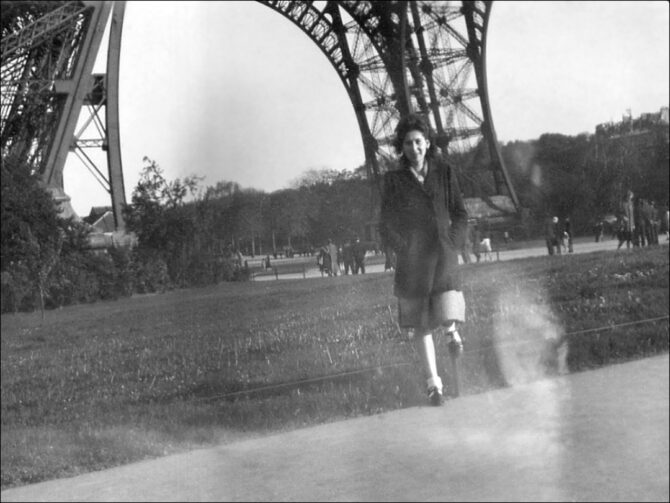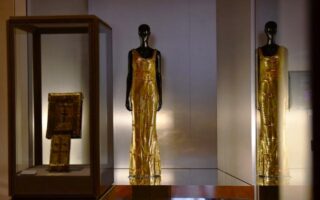Sinners and Saints: Ghostly Celebrities of the Seine
- SUBSCRIBE
- ALREADY SUBSCRIBED?
BECOME A BONJOUR PARIS MEMBER
Gain full access to our collection of over 5,000 articles and bring the City of Light into your life. Just 60 USD per year.
Find out why you should become a member here.
Sign in
Fill in your credentials below.
For more Paris hair-raising, goosebump-inducing tales, check out Hazel Smith’s fantastical story about ghosts in Paris
In Paris the leaves are falling, so snuggle tight. It’s time to re-crack open my faux fur-trimmed, pleather-bound volume of spirited adventures in the City of Light and Fright. I’ve been digging through old newspaper clippings for years, saving any having to do with my favorite saints and naughty sinners. Cutting to the ghostly chase, here are nine of them. Let’s go raise some spirits. Boo, la la.
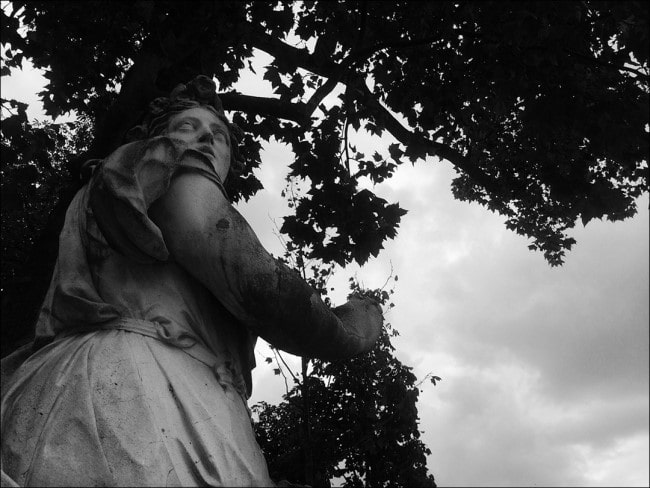
Whilst traipsing through the Jardin des Tuileries, watch out for “Le Petit Homme Rouge!” (“Pomona” by François Barois; photos by Theadora Brack)
Le Petit Homme Rouge
Whilst traipsing through the Jardin des Tuileries, keep your eyes peeled for “Le Petit Homme Rouge.” We have astrology-maniac Catherine de Médici to thank for this angel of vengeance. Prior to becoming an otherworldly imp, personal butcher Jean l’Écorcheur (a.k.a., “the Little Red Man”) had earned his bread as the queen’s favorite henchman.
After making a killing (so to speak), little Jean was murdered in turn by Catherine herself, no doubt because he knew too many of her darker secrets. Sometimes it just doesn’t pay to shine at the workplace. Like the old Russian proverb puts it, “The nail that sticks out gets hammered down.”
During his final moments Jean is said to have muttered, “Je serai de retour!” beating the Terminator’s “I’ll be back” by well over 400 years.
And back he came.
Like a bad penny, that’s how he rolled. “Le Petit Homme Rouge” not only revisited Catherine, but from time to time he made life hell for Henry IV, Marie Antoinette, Louis XVI, and even Napoleon — never spreading joy but always bringing horrific fortune to the royal lot.
“Heavy is the head that wears the crown,” they say, but that goes double when there’s an angry ghost butcher lurking near the throne.
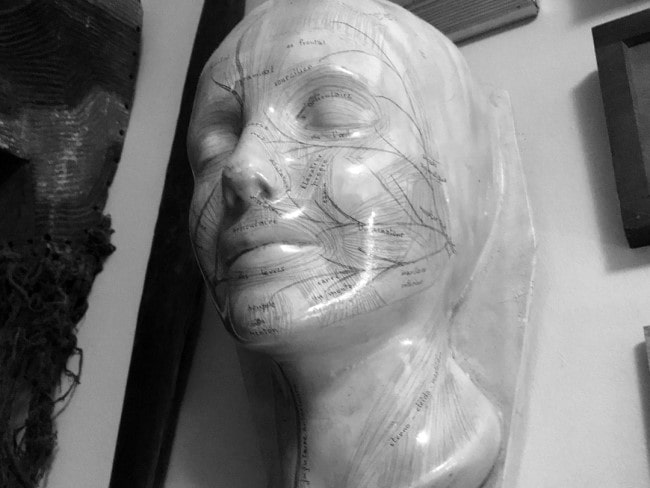
“L’inconnue de la Seine,” cast from an unknown 16-year-old who washed up on the banks of the river in the 1880s. (Theadora Brack photo; flea market find)
The Unknown Celebrity of the Seine
Among the artsy clutter that once adorned nearly every artist’s lair was a plaster face with a mysterious smile. These were cast from a famous death mask called “L’inconnue de la Seine,” made from an unknown 16-year-old who washed up on the banks of the river in the 1880s with an eerily pleasant expression on her corpse.
Copies quickly became popular fixtures in artists’ studios and salons as well as the inspiration for numerous literary works. Camus called her the “drowned Mona Lisa,” and Nabokov celebrated her in his poetry.
In the 1960s, the nameless girl’s visage was resurrected once again as the face of “Resusci Anne,” the rubber CPR training dummy. Because of this, hers is sometimes called “the most-kissed face of all time.” Consider tossing a flower in the water for her as you stroll along the Seine.
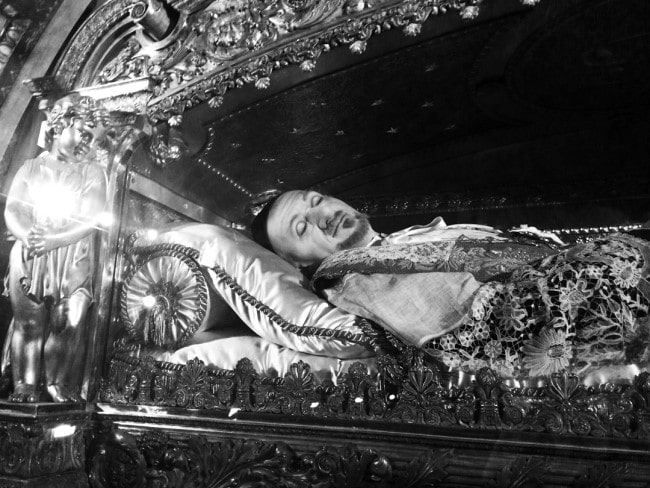
Saint Vincent de Paul at the Chapel of the Lazarists, located near Bon Marché department store on rue de Sèvres. (Theadora Brack photo)
Saint-Vincent de Paul
Whenever my mood needs a boost, I make a beeline to the Chapel of the Lazarists, tucked behind the Bon Marché department store on rue de Sèvres. It does the trick each and every time. Never looking more beautiful, here Saint-Vincent de Paul hovers over the altar. Sprightly, lightly tiptoe up the narrow flight of stairs in the back of the sanctuary for a closer view of the reposed gent and patron saint of horses.
Ordained as a priest in 1600, Saint Vincent not only championed the wealthy and the not-so-wealthy, but he also encouraged them to work together on charity missions financed by public subscriptions (much like today’s Kickstarter schemes). Fully embracing crowdsourcing on the streets, the ahead-of-the-curve saint fundraised for prisons, orphanages, and hospitals. Nobody got left behind.
What’s so funny about peace, love and understanding?
Absolutely nothing, according to Vincent. Besides, he wrote, “Calm will follow the storm!” A timeless mantra, I do believe. After all, who doesn’t desire a little more tranquility? Suddenly catching Vincent’s contagious optimism, perhaps it’s high time to volunteer with the École du Chat de Clichy organization. Mew it forward!
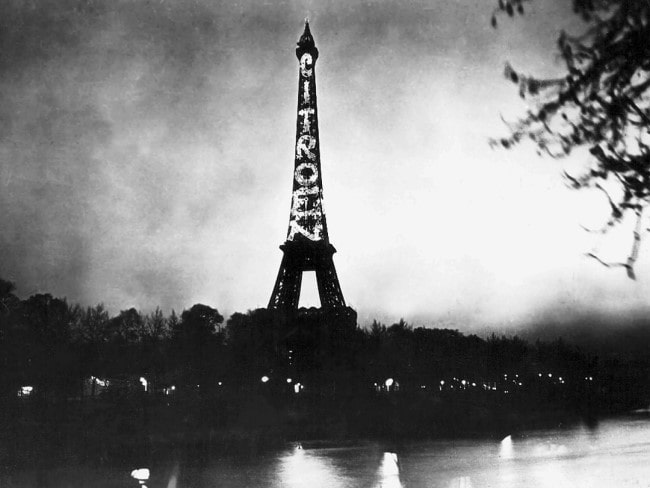
From the get-go, the Eiffel Tower has been a magnet for suicides. (The Citroën Sign Years, 1925-1934; Theadora Brack archives)
Princess Anna Troubetzkoy
A story I often tell: The world’s tallest building for more than 40 years, the Eiffel Tower was a virtual magnet for suicides. From the get-go, folks started jumping off it like there was no tomorrow. In fact, it’s still one of the most popular spots to commit suicide in all of Europe. She may not have been the first to say it, but perhaps she was the most memorable: “So sorry to rain on your parade,” Princess Anna Troubetzkoy shouted, as she leapt from the top on Bastille Day in mid-July 1931. At first it was ruled accidental, until a farewell note was found in her bag.
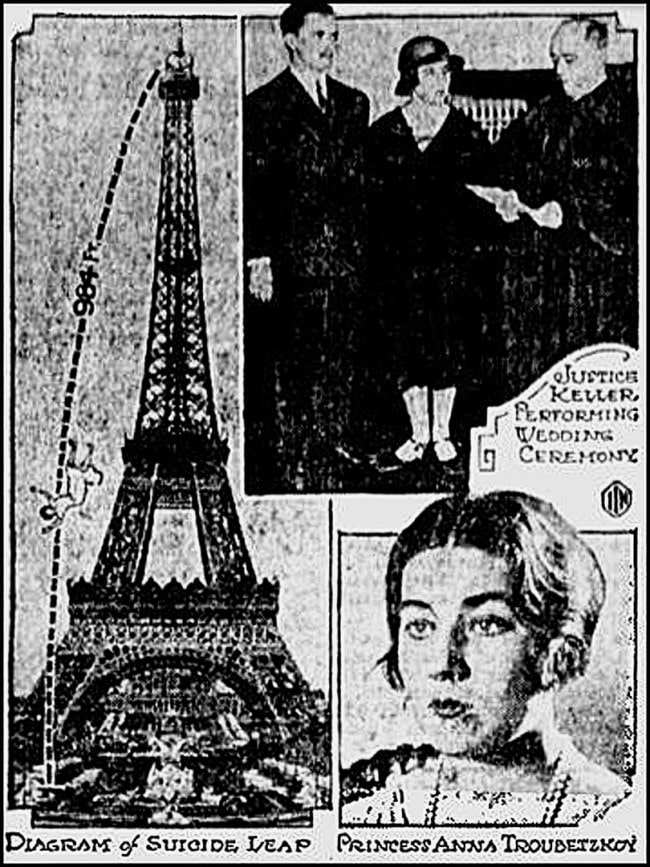
But was it suicide? According to Anna’s father, “Anna was never able to stand high places. Once she fainted on top of the Bank of Manhattan building in New York.”
Rumor has it
According to a cousin, the princess had seemed to be in a joyous mood, but a few months before, Anna had married a certain Prince Sergei in New York. They had kicked off their European honeymoon in June and were set to renew their four-month vows in August, when they would reach Russia. So what happened? Was she already envisioning endless crash diets and yet another round of dress fittings? Heck, we’ve all been there.
Nobody knows for sure, but obviously something had gone enough astray between the lovebirds to make her decide to fly the coop so dramatically.
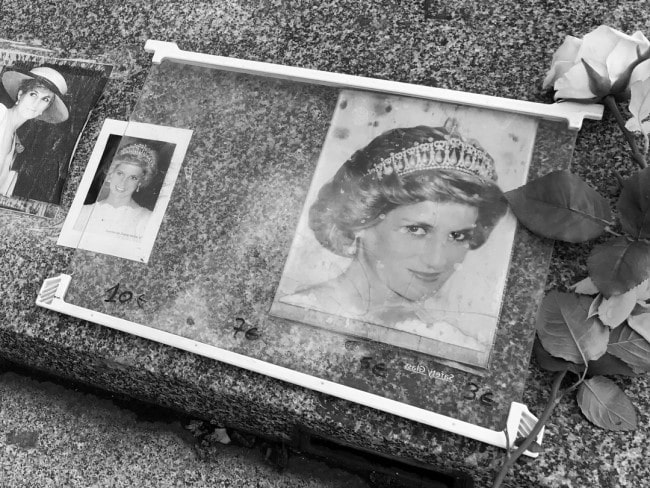
Pilgrims from all over the world still leave poems, flowers, collages, paintings, sculptures, and love letters. Tears, too. (Theadora Brack photo)
Pont-de l’Alma, Princess Diana
Just outside the Pont de l’Alma métro station is the “Flamme de la Liberté” memorial, which now serves double duty as the unofficial Princess Diana shrine. Pilgrims from all over the world still leave poems, flowers, collages, paintings, sculptures, and love letters there. Tears, too.
According to my friend Ghislaine, who worked on two documentary films about the crash that killed the fallen princess, “There are definitely ghosts in the Alma tunnel. After many nights spent filming there, I can tell you it’s eerie. It was as if Diana’s ghost was trying to urge us to find the truth. And I was certainly not the only one to feel this.”
Rest in peace, Princess Diana.
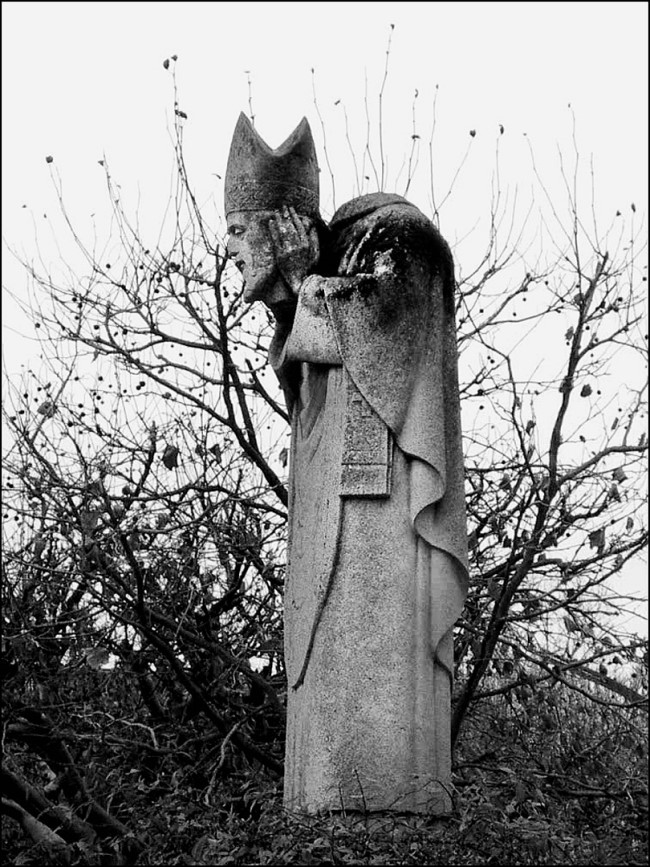
You’ll find Saint Denis in the Square Suzanne Buisson on rue Girardon in Montmartre, presiding over lively pétanque matches. (Roger Manley photo)
Saint-Denis
During my Rocky-inspired runs on the steep slopes of Montmartre, I often pay homage to Saint-Denis, the patron saint of both France and headaches. Why so, you ask? Well, after some Romans gave him the décapitation treatment in nearby Abbesses, he reportedly picked up his own head, hiked over the hill, and kept going for another eight kilometers (all the way to the eponymous suburb, in fact), stopping only once for some water. They always say it’s important to stay hydrated while exercising.
The saint’s weird statue is located in the little Square Suzanne Buisson at 7 rue Girardon, near the top of the hill. But if you go, for heaven sakes don’t be a bling menace. Back in the day, when some fool tried to steal one of the ornamental gold pigeons that once graced this site, he was suddenly pushed so hard by an invisible force that he took a tumble, falling on his very own lance. Ouch.
“R-E-S-P-E-C-T,” as Aretha Franklin would say. Just show some.
Terminology Time
Saint-Denis is far from the only saint to have kept on going like a certain Battery Bunny despite being rendered sans tête. Over the years enough of them accumulated, in fact, that the term “cephalophore” was coined, from the Greek for “head-carrier.”
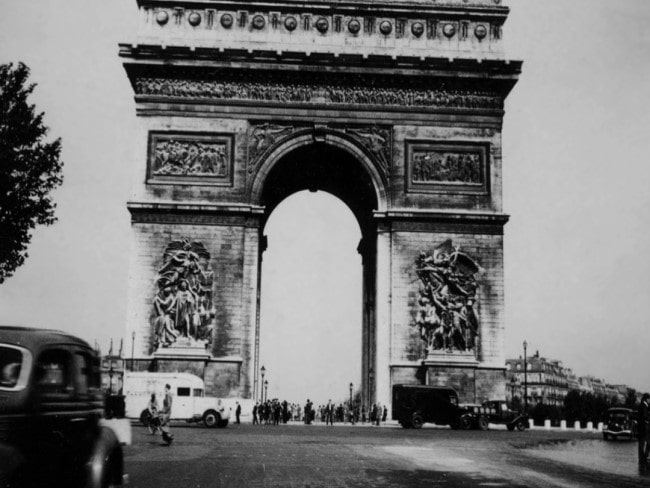
After quarreling with her beau at the Arc de Triomphe on Bastille Day in 1914, Rose jumped off the Arc de Triomphe rooftop. (Theadora Brack archives)
Rose at the Arc de Triomphe
Almost immediately after it was completed, people began heaving themselves off the Arc de Triomphe’s rooftop parapet, after climbing all 284 steps to get there.
(Did they not spot the gift shop?)
Occasionally a skirt would tangle and catch on a cornice, leaving the poor women (which nearly all of them were) dangling a few long moments above the horrified crowds below, until the seams would give way and they’d plunge to their deaths.
Figuring out which police station to contact after one of these unfortunate incidents has always been a major source of confusion, because the monument sits at the juncture of four arrondissements and they’ve never clearly settled whether it’s the departure spot or the point of arrival (i.e., the sidewalk) that should be the determining factor when establishing proper jurisdiction.
Atop the Arc, look out for a particular spirit named Rose. After quarreling with her beau on Bastille Day in 1914, Rose jumped, narrowly missing throngs of tourists in her tumble. Our hobble-skirt clad fashionista was “dressed expensively and well,” according to the newspaper report.
Just what is it about Bastille Day that drives folks to make the leap? Is it the uniforms or the martial music?
Just to End It All on an Odd Number: Cimetière du Père-Lachaise
After dancing with the stars in Montmartre’s little marble orchard, trek it on over to the vast Cimetière du Père-Lachaise, where you’ll not only find the graves of famous folks like Chopin, Balzac, Modigliani, Proust, Oscar Wilde, Edith Piaf and, some say, Jim Morrison, but also a few final resting places that are even more interesting because of the behaviors they induce.
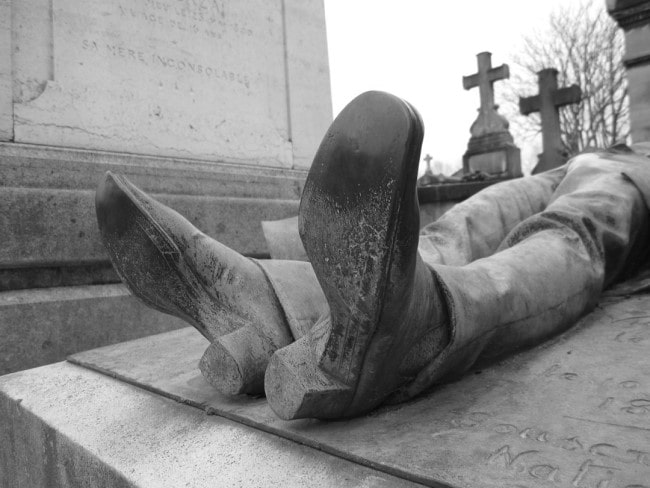
If you are looking for un grand amour, sit a spell with Victor Noir’s life-sized bronze monument, sculpted by Jules Dalou. (Theadora Brack photo)
Victor Noir
According to legend, if you are looking for un grand amour, Victor is your man. Shot in a duel by Prince Pierre Bonaparte in 1870, political journalist Noir became a heroic martyr overnight. Now sculpted in bronze by Jules Dalou in a sexy, hyper-realistic style, he comes “fully equipped.” They say that if rubbed in all the right bright coppery spots, Noir will not only miraculously assist with love and marriage, but also with the baby carriage.
After a session, kissing his shiny lips and leaving a perky flower in his bronze top hat typically seals the deal.
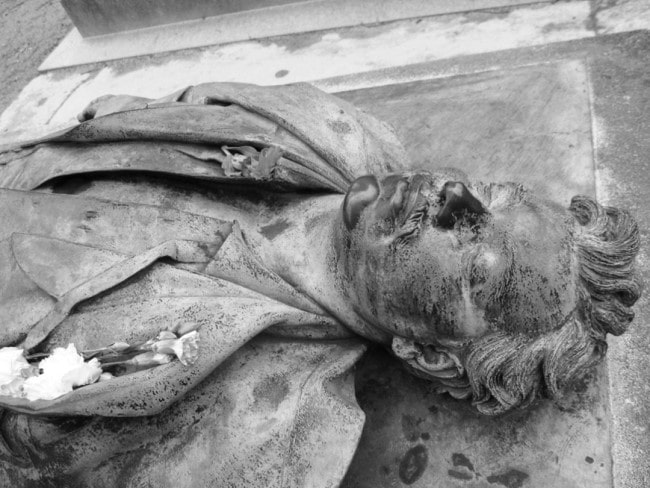
Shot in a duel by Prince Pierre Bonaparte in 1870, political journalist Noir became a heroic martyr overnight. (Theadora Brack photo)
While sitting on a bench
I once spotted a woman singing Freddie Mercury’s “Somebody to Love” song as she touched Victor’s lips with her fingertips. Here, hope is palpable, and it soothes and re-energizes me at the same time. Surrounded by this potent mix of past and present, everything always feels possible.
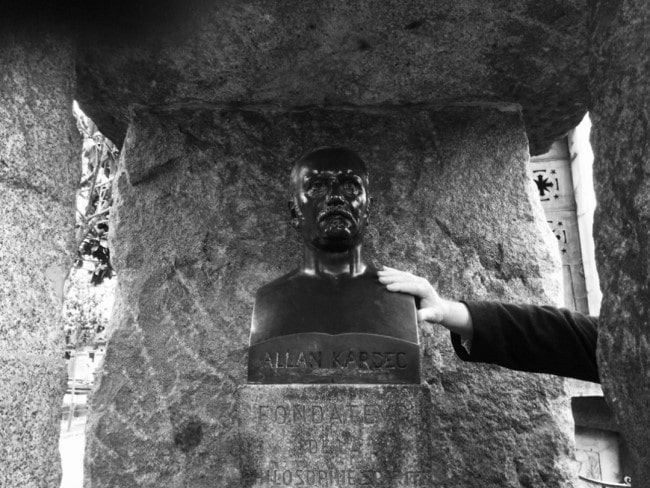
Talk to the hand: believer reaching out to Allan Kardec. (Theadora Brack photo)
Allan Kardec
Speaking of wish-granting graves, one of my favorites is that of Allan Kardec in section 44. Here you can discreetly watch as true believers in spiritualism come to caress the shoulders of the bronze bust glaring from its niche (under what looks to be a crude prehistoric dolmen), and to whisper messages in his ear in order to “telephone” their dead loved ones, while often putting in requests for winning lottery numbers. Here, a rough red stone typically seals the deal. Keep your peepers on Monsieur Kardec’s peepers. If he is somewhere around in the little grotto, some say, he’ll respond from beyond by opening and shutting his eyes.
Behind the tomb is an official warning from the city of Paris (akin to the surgeon-general’s warning on a pack of cigarettes) to the effect that the municipal government can’t be sued if your lotto numbers don’t win. On the flipside: France is still a hotspot of afterlife activity — it’s no accident that words like séance, clairvoyant, and déjà vu are all French terms. So Bonne Chance!
Seize the day! Because as my friend Paul’s mother Millie says, “You only live once — in a while.”
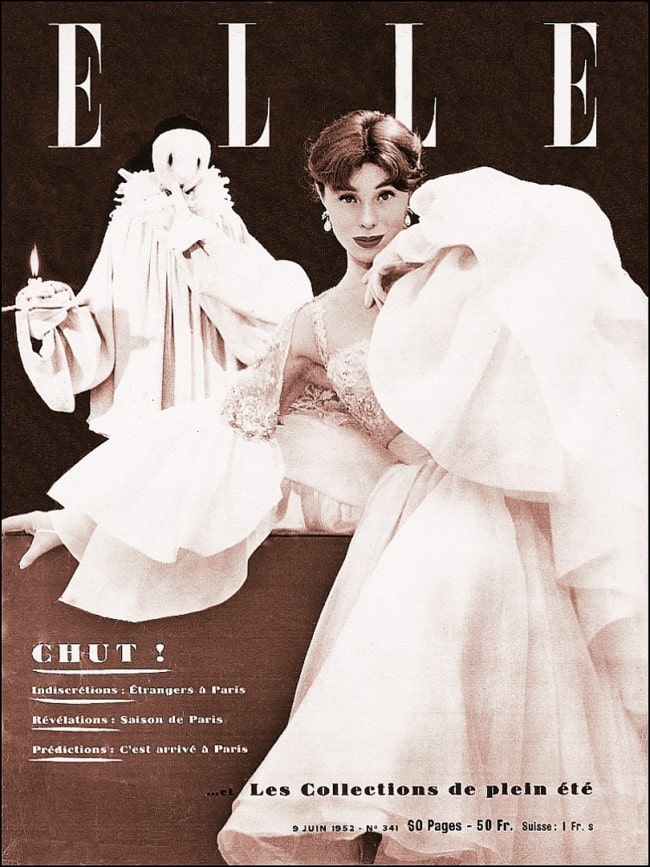
Carpe Diem! Keep shining the light! (Elle magazine, 1952; Theadora Brack collection)
Lead photo credit : (C) Theadora Brack
More in history, Paris history, park, statue
